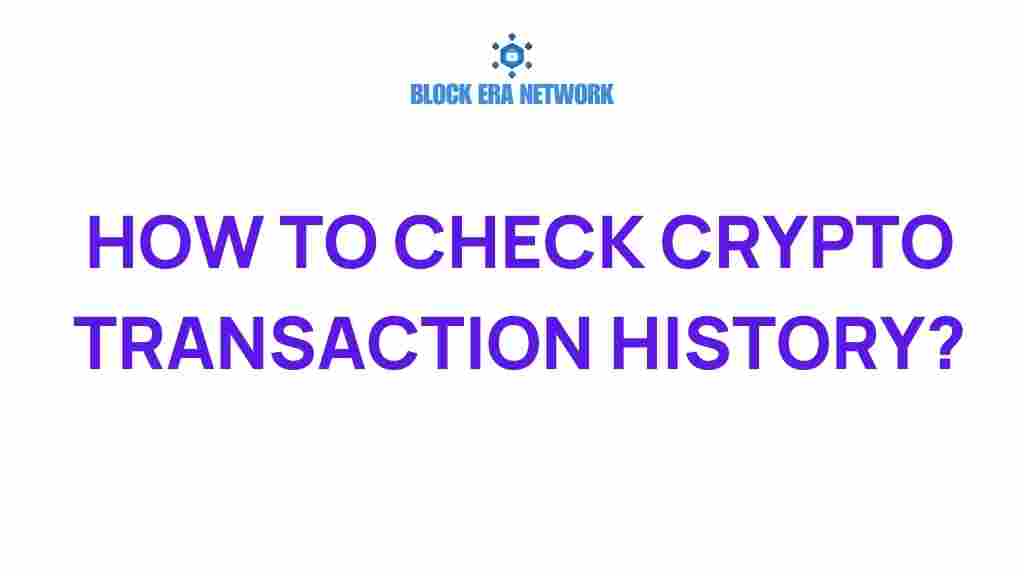Unlocking the Secrets: How to Check Your Crypto Transaction History
In the ever-evolving world of cryptocurrency, understanding your crypto transaction history is crucial for managing your digital assets effectively. As blockchain technology gains traction, more individuals are turning to cryptocurrencies for investment and transactions. However, navigating your transaction records can be daunting without the right knowledge. This article will guide you through the process of checking your crypto transaction history, ensuring you maintain financial transparency and effectively track your transactions.
Understanding Crypto Transaction History
Your crypto transaction history is a record of all transactions made with your cryptocurrency holdings. This history includes details such as:
- Transaction dates
- Transaction amounts
- Sending and receiving wallet addresses
- Transaction fees
- Status (confirmed or pending)
Each transaction is recorded on the blockchain, which is a decentralized ledger that ensures transparency and security. By understanding your transaction history, you can monitor your investments, verify transactions, and maintain accurate records for tax purposes.
Why is Tracking Your Crypto Transactions Important?
Tracking your crypto transaction history is essential for several reasons:
- Financial Transparency: Keeping an accurate record of your transactions helps you understand your financial situation better.
- Tax Compliance: Many jurisdictions require reporting of cryptocurrency transactions for tax purposes.
- Fraud Prevention: Regularly checking your transaction history can help you spot unauthorized transactions quickly.
- Investment Strategy: Monitoring your trades can provide insights into your investment performance and assist in making informed decisions.
How to Check Your Crypto Transaction History
Now that we understand the importance of tracking your transaction history, let’s dive into the step-by-step process of checking your crypto transaction history.
Step 1: Access Your Digital Wallet
Your digital wallet is where your cryptocurrencies are stored. It could be a software wallet, hardware wallet, or an online wallet provided by a cryptocurrency exchange. To begin checking your transaction history:
- Open your digital wallet application or website.
- Log in using your credentials (username and password).
- Ensure your wallet is secure and that you are accessing it from a trusted device.
Step 2: Navigate to the Transaction History Section
Once logged in, look for the section labeled ‘Transaction History’ or ‘Activity’. This location may vary depending on the wallet you are using. In general, you should:
- Find a tab or link that says ‘Transactions’, ‘History’, or ‘Activity’.
- Click on it to view your transaction history.
Step 3: Review Your Transactions
Your transaction history will display a list of all transactions associated with your wallet. Review the following details:
- Date: When the transaction occurred.
- Amount: How much cryptocurrency was sent or received.
- Wallet Address: The addresses involved in the transaction.
- Transaction ID: A unique identifier for the transaction.
- Status: Confirmed or pending status of the transaction.
Step 4: Use Blockchain Explorers
If you want to verify your transaction history or access more detailed information, you can use a blockchain explorer. These tools allow you to view all transactions on a specific blockchain.
- Go to a reliable blockchain explorer website (e.g., blockchain.com).
- Enter your wallet address in the search bar.
- Review the transactions associated with your address.
Step 5: Export Your Transaction History
Many wallets and exchanges offer an option to export your transaction history. This can be useful for tax reporting or personal record-keeping. To do this:
- Look for an ‘Export’ or ‘Download’ option in the transaction history section.
- Choose your preferred file format (e.g., CSV, Excel).
- Save the file to your device for future reference.
Troubleshooting Tips for Checking Your Crypto Transaction History
Sometimes, you may encounter issues while trying to check your crypto transaction history. Here are some common problems and their solutions:
Problem: Unable to Log In
If you cannot access your digital wallet, ensure:
- Your internet connection is stable.
- You are entering the correct credentials.
- Check if the wallet service is experiencing downtime.
Problem: Incomplete or Missing Transactions
If some transactions are missing, consider the following:
- Ensure you are using the correct wallet address.
- Check if the transaction was sent to another wallet.
- Use a blockchain explorer to verify the transaction on the blockchain.
Problem: Difficulty Using a Blockchain Explorer
If you are unsure how to use a blockchain explorer, follow these steps:
- Consult the help section of the explorer website.
- Look for tutorial videos online.
- Practice using the explorer with known transactions to gain familiarity.
Conclusion
Checking your crypto transaction history is a vital part of managing your cryptocurrency investments. By understanding how to access your digital wallet, navigate your transaction history, and utilize blockchain explorers, you can maintain financial transparency and ensure you are aware of all your transactions. Regularly monitoring your transaction history not only helps in tax compliance but also protects you from fraud and aids in developing effective investment strategies.
As you continue your journey in the crypto space, staying informed and vigilant about your transaction history will empower you to make better financial decisions. Remember, the world of cryptocurrencies is vast and complex, but with the right tools and knowledge, you can navigate it successfully.
For more insights into cryptocurrency management, check out our [comprehensive guide on digital wallets](#) and explore how you can maximize your investment potential in the crypto market.
This article is in the category Cryptocurrency Insights and created by Block Era Network Team
